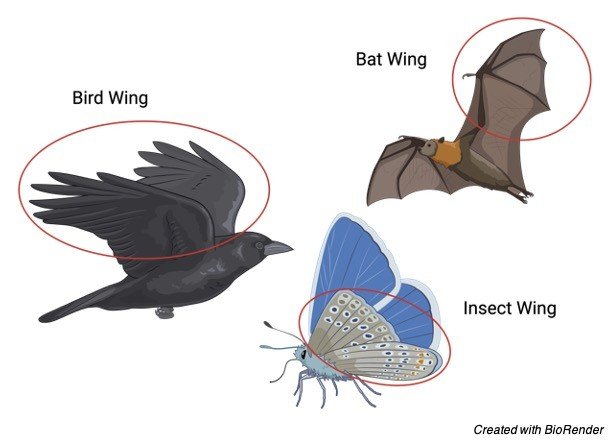Table of Contents
Analogous Structures Definition
Analogous structures in evolutionary biology are biological structures with comparable or related functions but not from the same evolutionary origin. In other words, these biological features are used by species for the same function, despite the fact that these species come from different evolutionary lines.
Convergent evolution is the name given to this type of evolution. Convergent evolution occurs when animals evolve structures or functions that are comparable (analogous) to those of their evolutionary forebears, despite their evolutionary ancestors being highly distinct or unrelated. As a result, even if they developed from distinct evolutionary origins, homologous structures in unrelated species might have similar or matching functions.
Analogous Structures Examples
A bird’s wing and an insect’s wing are similar organs. Both of these animals have wings and use them to fly, yet their wings have different evolutionary origins. Therapod dinosaurs, especially Maniraptora members, are thought to be the evolutionary origins of birds. In the case of insects, their evolutionary history is unknown.

The origins of insect flying are unknown. The paranotal hypothesis proposes that their wings evolved from the paranotal lobes of the thoracic terga, according to one prevalent theory. Winged insects may have originated from a terrestrial rather than an aquatic progenitor, according to phylogenomic studies.
Analogous structures may not have to be of the same structure, as seen in the example. Birds’ wings are modified forelimbs in general. The humerus, ulna, and radius are the bones that make up their forelimbs. These bones, like the rest of the skeleton of a bird, are light. This is, in fact, one of the most important characteristics of birds that can fly. They have air sacs in them and are mostly hollow bones to save weight.
The existence of flying feathers at the tips of the wings is another modification that allows them to fly. The structure of the bird’s feathers gives the bird its initial lift and later its real powered flight. In the case of insects, the wing is an extension of the exoskeleton seen in the mesothorax and metathorax. The forewings are the paired wings that emerge from the mesothorax, whereas the hindwings emerge from the metathorax. Their wings do not have the same bone structure as birds’ wings.
Rather, the insect wings are made up of crisscrossing veins, with a nerve, a trachea, and hemolymph running through each of the main veins. The veins are surrounded by a cuticle, which thickens and supports the insect wing structurally. Instead of feathers, the insect wing possesses two types of hairy structures: microtrichia (finer) and macrotrichia (bigger) (larger).
Aside from the bird wings and insect wings mentioned above, here are some additional structures that are similar:
1. Vertebrates, cephalopods (squid and octopus), cubozoan jellyfish, and arthropods (insects, spiders, and crustaceans) developed their sophisticated eyes independently. Their eyes, on the other hand, are mostly used for vision.
2. The shells of brachiopods and bivalve mollusks are remarkably similar.
3. Plant hormones such as gibberellin and abscisic acid, which are produced by both plants and fungus.
4. Analogous organs include the sense of smell organs. An analogous organ is one that operates similarly to an organ from a different species but evolved at a different time. The sensilla of insects are comparable to the smelling organs of the terrestrial coconut crab. They both evolved organs that can sense odours in the air and flip antennas for better reception.
Analogous Structures vs Homologous Structures
Homologous structures are those that have a common ancestor or have the same evolutionary or developmental origin. Homologous structures may or may not serve the same purpose. Human and bat forelimbs are examples of homologous structures.
Humans and bats share the same core skeletal structure, which originated from the same components and is derived from the same embryonic origin. They are both mammalian in origin. Their forelimbs, on the other hand, are employed in a different way. The bats fly by using their forelimbs. The radius, like that of other mammals, is the most important component of the bat forelimb.
The digits, on the other hand, are extended and webbed, extending around the wrist. The patagium membrane, which extends between the arm and finger bones, is a fragile membrane. Muscles, nerves, blood arteries, and connective tissues make up the membrane, which is an extension of the skin.
Analogous structures, in contrast to homologous structures, have comparable functions but evolve separately. The fins of fish and the flippers of whales (mammals) are similar features of evolutionarily unrelated creatures that utilise them for swimming but do not have a common ancestor.
The anatomical features of analogous and homologous structures may differ, but the anatomical features of homologous structures may be identical. Homologous structures have comparable tendencies in terms of development, whereas analogous structures do not.
One might look at their common ancestors to see if the structure is similar to that of another species. As previously stated, analogous structures are structures that have a comparable or equivalent function but do not have the same evolutionary origin as the two species under investigation.
The Evolutionary Process
Convergent evolution is the process through which organisms evolve identical structures (or functions) despite their progenitors being substantially different or unrelated. The structures in the two species must have the same purpose, but they do not have to have the same physical characteristics to be called similar.
Analogous structures do not have a similar ancestral origin since they differ in anatomy and developmental origin. They evolve independently of the characteristics or qualities that they share.
The adaptation of the species to a comparable environment is linked to the production of equivalent structures. For example, the smelling organ of a coconut crab differs significantly from that of other crabs, resembling more like an insect sensilla. Their comparable terrestrial modes of existence have resulted in homologous structures.
Unlike crabs that live in water, the coconut crab spends more time on land, using its highly developed sense of smell to locate food sources (such as the scent of rotting flesh) over vast distances. By exposing the dwelling species to the same environmental variables and limitations, the same habitat and ecological niche might induce similar structures to develop amongst species of different lineages.
Analogous structures give evidence for evolution since they exist. This implies that species develop in reaction to their surroundings and as a measure of their ability to fit in and survive. They may have formed an anatomically comparable structure to those of their lineage, but the function may serve a different purpose that is more appropriate for their ecological environment. Analogous structures indicate that unrelated species evolve in ways that are both similar and distinct.
Analogous Structures Citations
Share












